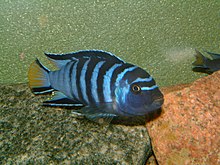Mbuna


Mbuna is the generic term for several genera of cichlids (Cichlidae) that are endemic in Lake Malawi ( East Africa ) , i.e. only occur there. Mbunas are rock dwellers who in the shorelines of Lake Malawi in the rock littoral are native. The local fishermen have coined the name, which has been adopted by aquarists around the world. All genera not tied to the rock biotope are called Utaka .
behavior
The genera of the Mbuna are quite aggressive, there are of course some exceptions. The males usually form territories for which they often fight to the death. The females of some genera also occupy small territories, mostly just simple caves that they inhabit. In the literature these small areas are often referred to as feeding areas.
Reproduction
The animals are mouthbrooders . After laying eggs, the female takes the eggs into her mouth and hatches them there. The male does not take part in the care of the brood ( mother family ).
The Mbuna or Malawi Basin
For a Mbuna or Malawi tank, an aquarium with at least 300 liters of water, or better, more, is a prerequisite to enable “species-appropriate” maintenance. The aquarium must have a temperature between 23 ° C and 26 ° C, whereby the fish are much livelier at the higher values, but also eat more and thus pollute the water more.
For a mbuna aquarium - for fresh water - very strong currents (flow pumps) are necessary to meet the high oxygen demand. You should circulate at least 2–3 times the volume of the pool in an hour, but 10–15 times as much does not have to be too much. High- performance filters that keep the water pollution at a tolerable level are required for filtering . In addition to a weekly water change of at least 50%, modern filter materials are the most important stabilizers. Please note that the water must be in the alkaline range ( pH value approx. 7.5–9).
A Mbuna basin is mainly equipped with rocks (no sharp-edged stones) and is therefore also known as a rock basin . Only a few plants have a chance to withstand the attempts of the fish to eat. The following plants have proven themselves: Cryptocoryne aponogetifolia , Cryptocoryne affinis or the large number of African spear blades such as the dwarf spear blade and the Java fern . However, these are plants that do not occur in the natural biotope of the mbuna. In Lake Malawi, in addition to the algae growth on the rocks, there are only Vallisneria and Potamogeton stocks on the sandy areas.
The socialization of the Mbunas with one another is not always straightforward. An overstocking is often maintained in the aquarium, as the stress concentration on individual fish is not that high. Furthermore, you should avoid keeping Mbuna males with similar markings together, otherwise violent fights with fatal results and there is a very high risk of hybridization. The ratio of males to females should be at least 1: 3-5 or 3: 7.
Genera
- Abactochromis
- Chindongo
- Cyathochromis
- Cynotilapia
- Genyochromis
- Gephyrochromis
- Iodotropheus
- Labeotropheus
- Labidochromis
- Maylandia
- Melanochromis
- Petrotilapia
- Pseudotropheus
- Tropheops
Especially the colorful representatives are popular aquarium fish .
